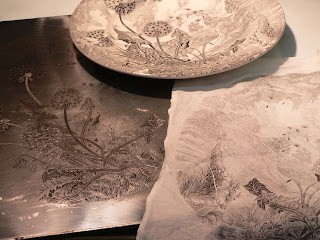 |
| Add caption |
Thursday 21 March 2013
Thursday 14 March 2013
A Visit to the Trasfer Room at Burleigh
| Transfer tissue being printed |
| Cow creamers with transfers pressed into place |
| Cups, ready to be brushed with soap |
| A conveyor transports the wares to be washed, prior to firing. |
After some initial tests here at the CFPR, I realised that I needed some lessons on the art of transferring. I spent a couple of days with the lovely ladies in the transfer room at Burleigh, learning lots of tricks and tips - a teacup was even sacrificed for me to practice on. Unfortunately, it didn't make it on to the conveyor belt as it failed the first quality inspection! I was praised for my efforts, not too bad for a beginner.
It was great to spend some time there- looking around the factory, getting a good look at the presses and some proper northern banter from the workers!
I've now got plenty to be getting on with and hope to have made a good amount of progress on both plates and ink before my next visit.
Tuesday 5 March 2013
Settling in.
I thought I'd start this blog by posting a few photo's from my first month here. I've been finding my feet - learning very basic ceramics, trawling through old books for info on the transfer process and setting up the wee workshop. I've made some ink, printed some transfers and fired some simple tiles which we then took to show the folks at Burleigh. They kindly let me borrow a beautiful, old hand engraved copper plate which I've been proofing. I'll then work with this image digitally and have a flexo plate produced so that I can compare results from both plates.
| The workshop, complete with fancy press and pretty worktops |
| A close up of the engraved copper plate (with chrome facing) from Burleigh |
 | |
| Transferring a printed image |
The transfer room at Burleigh
Here's a short video that The Guardian posted recently, showing the transfer room at Burleigh. You'll see the tissue being printed, hung on lines and passed around the room on pulleys. They are then trimmed down to size and pressed onto the wares, ready to be glazed and fired.
Project Overview
The Centre for Fine Print Research (CFPR) has been awarded an Arts and Humanities Research Council (AHRC) grant worth £119,970 for a 12 month project starting in February 2013 called 'Combining Digital Print Technologies with 18th Century Underglaze Ceramic Process'. Professor Stephen Hoskins and Dave Huson are collaborating with industry partner Burleigh Pottery in Stoke-on-Trent - the last remaining company to produce ceramic tableware decorated using the traditional printed underglaze tissue method. Underglaze tissue ceramic transfer printing was first developed in the mid-18th century and involved the use of engraved or etched metal plates, from which the tissue was printed with cobalt blue colour- the famous 'Willow Pattern' being a well-known example. Underglaze tissue has a very distinctive, subtle quality - it is an integral part of English ceramic history and cannot be replicated by any other means. This project builds upon previous AHRC funded research undertaken in 2000 in which Stephen researched the combination of the digital capabilities of flexographic printing technology and the earliest printing processes first developed for the ceramic industry in the 1780s. In this new project the team will work with Burleigh to consolidate a commercial future and retain the unique skill-base for this historic, very English process whose development is part of a unique English form and thus of our cultural heritage. Linsay Proctor has been appointed to work on this exciting project and we welcome her to the CFPR team.
Subscribe to:
Posts (Atom)
